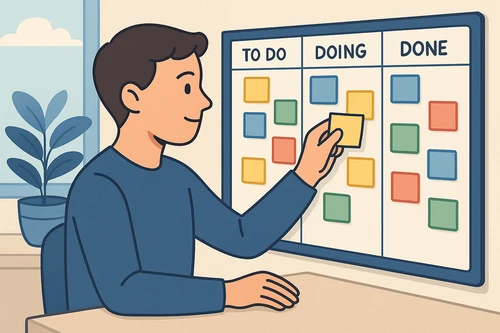Before diving in, let’s briefly define ADHD (Attention-Deficit/Hyperactivity Disorder) — not from a medical standpoint, but from a practical perspective that connects to everyday challenges.
ADHD is a neurodevelopmental condition that often manifests through difficulty focusing, staying organized, prioritizing tasks, and managing time effectively. These struggles can make daily life feel overwhelming — especially when responsibilities pile up.
Now, here’s where it gets interesting: Kanban methodology, a visual workflow management system used in Agile project management, can be a game-changer for people with ADHD. It transforms how tasks are seen, organized, and accomplished, providing a structure that supports focus, reduces stress, and builds confidence.
Let’s explore why Kanban Boards (and similar visual systems like Scrum Boards) can serve as an effective, low-effort tool for people with ADHD — and even for anyone seeking better focus and organization.
1. It Makes Everything Visual
One of the biggest challenges for people with ADHD is keeping track of what needs to be done. Mental to-do lists tend to vanish, and digital task managers can quickly become cluttered or forgotten.
A Kanban Board changes that completely.
It brings your workflow into the physical world — something tangible and visible. Each task is represented by a card, moving from one column to another (“To Do,” “In Progress,” “Done”) as you make progress.
This visual clarity provides a constant reminder of priorities and accomplishments, helping people with ADHD stay oriented without relying solely on memory or planning. The board almost “thinks” for you — quietly reminding you what’s next, reducing anxiety, and removing decision fatigue.
2. It Simplifies Prioritization
For people with ADHD, everything can feel equally urgent — which often leads to decision paralysis. Kanban helps break that cycle.
By organizing tasks into columns and categories, it forces prioritization naturally. You can assign what’s most important to the “To Do” list, move less critical items into the “Backlog,” and tackle work in manageable order.
This structure replaces mental chaos with clarity. It becomes obvious what deserves your attention first — and that alone can relieve a huge cognitive burden.
3. It Encourages Focus on One Task at a Time
A common symptom of ADHD is overwhelm — the feeling that there’s just too much to do. Kanban addresses this by emphasizing Work-In-Progress (WIP) limits, meaning you can only take on a small, manageable number of tasks at once.
If you’re someone who feels paralyzed by endless to-dos, the board teaches you to slow down and focus. You can start with a single task — just one card — and move it across the board until it’s done. That simple, physical act of progress creates a sense of accomplishment and control, which can be deeply motivating.
Over time, this method trains the brain to work in short, focused bursts, a rhythm that aligns perfectly with ADHD tendencies.
4. It Builds Routine and Reduces Stress
Consistency and structure are powerful allies for people with ADHD. A Kanban Board creates both.
Each time you interact with your board — moving a card, adding a note, or marking something as complete — you reinforce a productive routine. It becomes an external system of accountability and clarity, reducing the mental load of remembering what to do next.
And because everything is visual and tactile, it also satisfies the need for stimulating engagement — a small but significant factor in managing ADHD-related restlessness.
Ultimately, Kanban brings a sense of calm. It turns abstract pressure into something visible and conquerable.
5. It Aligns Naturally With ADHD Needs
What makes Kanban so effective for ADHD isn’t that it was designed for it — it’s that its principles perfectly complement how ADHD minds work.
People with ADHD tend to think visually, crave structure, and benefit from immediate feedback. Kanban provides all three. It turns planning into a visual experience, transforms progress into a game-like process, and creates positive reinforcement through visible achievement.
It’s not a medical treatment — but it can absolutely be a lifeline for anyone who struggles with organization and focus.
Final Thoughts
ADHD can make day-to-day life feel chaotic, but the right systems can change everything. Kanban and Agile visual boards bring order to that chaos — not by demanding strict discipline, but by designing an environment where productivity becomes effortless.
At PMXBOARD, we’ve seen firsthand how physical Kanban and Agile boards can help people — not just in workplaces, but in personal lives, classrooms, and home environments. Sometimes, the simplest tools make the biggest difference.
If you or someone you know faces ADHD-related challenges, try a physical Kanban Board. You might be surprised how much calmer, clearer, and more in control life can feel.


